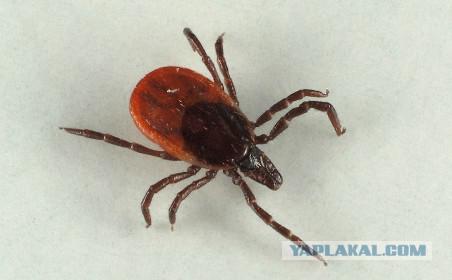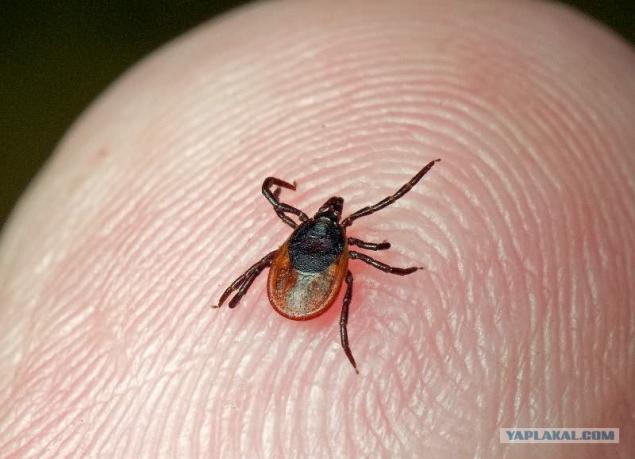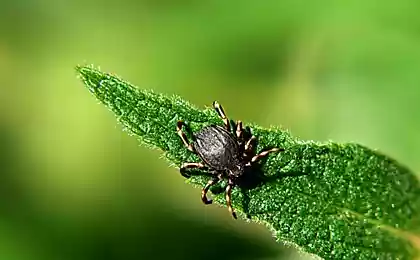717
10 myths about ticks
Oil drip on the tick and wait when he creep himself - meaningless
7 April at the initiative of the World Health Organization (WHO), every year is World Health Day. World Health Day 2014 will be held on the theme of "vector-borne diseases." Such diseases include tick-borne viral encephalitis and tick-borne Lyme disease.
At the same time, public awareness of the measures of prevention are often wrong. About the myths of viral encephalitis and tick-borne borreliosis told entomologist Center for Hygiene and Epidemiology in the Republic of Tatarstan Ekaterina Chernova.

Myth №1. Hazardous mites are found only in Siberia and the Far East
E.CH .: False. Although 70 percent of cases of tick-borne viral encephalitis is most often recorded in Siberia and the Urals, areas of concern on the incidence of this disease are also Tver, Yaroslavl, Kostroma, Leningrad region. Among the natural foci of tick-borne borreliosis, in addition to the above, also includes Tomsk, Sverdlovsk, Vologda regions, the Republic of Tatarstan.
Posted in [mergetime] 1397802851 [/ mergetime]
Myth №2. Ticks are found only in the forests
E.CH .: False. Among the mites that live in Tajikistan, there are views of the pasture. Therefore, an attack to be feared in the fields, edges and clearings. In recent years, the index of dominance of pasture ticks is growing significantly. Moreover, in recent years the mites tend to parks, gardens and other recreational areas.
Posted in [mergetime] 1397802878 [/ mergetime]
Myth №3. Ticks are dangerous only in May and June
E.CH .: phenological observations As 2013 ticks were several peaks of activity: the first in mid-April and the second - in August. Peak tick aggression traditionally falls in May. Attacks may be wary of ticks from April until the first snow.
Posted in [mergetime] 1397802896 [/ mergetime]
Myth №4. Ticks attack from the trees
E.CH .: This is not the case. The maximum height for tick habitat is less than 1, 5 m. The parasite traps its prey in the grass and stems along the paths and tracks, which move people and animals. Trailers using claws and suckers on the legs to clothing or fur mites crawling up in search of a warm and comfortable place to suction (places with thin skin or where wear loose clothing), which takes about 30 minutes.

Myth №5. Repellents - reliable protection from ticks
E.CH .: protivokleschevoy preparations applied directly to the body, does not exist. Even when applying repellents in compliance with the instructions they weathered a few hours and require periodic repetition of the procedure. Besides, ticks, a sense of closeness of the blood vessels, increasing the speed of suction so that substances toxic mites, do not manage to prevent the bite.
Posted in [mergetime] 1397802929 [/ mergetime]
Myth №6. Ticks prefer people in white clothes
E.CH .: This is not the case. Vision Aids ticks so primitive, that does not allow them to distinguish colors. Hunting tick sitting on the grass, or the lower branches, outstretched front legs, and just grabs them at anything that moves past - regardless of color. The scientists used a white cloth to collect ticks because on it they are more visible. So, the next time you go into the forest, more attention paid to the quality of things, not the color. Pants and jacket shall be fitted with elastic bands.

Myth №7. Tick bites can be seen by the increase in size reddening
E.CH .: False. This identification mark is relevant only in relation to borreliosis. And then not always. In 50 percent of the tick bite occurs without redness (erythema). In addition, during a tick bite allocates painkillers. Hence the rule: coming home with woodland walks, carefully inspect your clothes and body and take a shower.
Posted in [mergetime] 1397802952 [/ mergetime]
Myth №8. The closer the tick has stuck to the head, the faster will develop the disease if the tick immediately and remove the infection can be avoided
E.CH .: This is not true. Enter the blood borne encephalitis virus is spread hematogenically (ie with blood) around the body. Unfortunately, even if the tick bite was short-lived, the risk of contracting tick-borne infections is not excluded.

Myth №9. Having found on the body of the tick, you need to fill it with sunflower oil. He crawl
E.CH .: Removing stuck tick needed immediately, but be very careful not to break the proboscis, which is inserted deep and well strengthened in the human body. You can do this by throwing a loop of the parasite from a strong thread as close as possible to its mouthparts, twist it several times and gently pull. Oil drip on the tick and wait when he creep himself - meaningless and dangerous waste of time. It will be useful to purchase a device for extracting ticks, you can find it in stores for recreation and tourism.
Extracted from the skin "trophy" do not destroy or dispose of, and place in a glass bowl and take it to the Center for Hygiene and Epidemiology in the Republic of Tajikistan or in the laboratory, having the appropriate accreditation, which will determine whether the infected tick borne by you or virus encephalitis borreliosis. This will allow physicians not only time, but also provide competent medical care. After all, viral and bacterial diseases are treated differently: tick-borne encephalitis - protivoentsefalitnogo administration of gamma globulin, Lyme disease - antibiotics. The sooner this happens, the greater the chance that you will avoid the dangerous health effects.
Posted in [mergetime] 1397803006 [/ mergetime]
Myth №10. Vaccination against tick-borne encephalitis solves all problems
E.CH .: Even if you're vaccinated against tick-borne encephalitis, do not relax. Tick bite you can be a carrier of Lyme disease, and even (borreliosis). From her because of its bacterial vaccines do not exist.
As a rule, the disease is hidden, virtually asymptomatic, moving in such forms when the root cause is very difficult to learn, and to deal with it is particularly difficult. In any case, important timely diagnosis and treatment assignment.
It must be remembered that the time taken preventive, diagnostic and therapeutic measures, whether it's the right equipment on a forest walk or timely access to a medical facility, will help to keep your health.
ati-times.tatar-inform.ru/news/society/2321/

Source:
7 April at the initiative of the World Health Organization (WHO), every year is World Health Day. World Health Day 2014 will be held on the theme of "vector-borne diseases." Such diseases include tick-borne viral encephalitis and tick-borne Lyme disease.
At the same time, public awareness of the measures of prevention are often wrong. About the myths of viral encephalitis and tick-borne borreliosis told entomologist Center for Hygiene and Epidemiology in the Republic of Tatarstan Ekaterina Chernova.

Myth №1. Hazardous mites are found only in Siberia and the Far East
E.CH .: False. Although 70 percent of cases of tick-borne viral encephalitis is most often recorded in Siberia and the Urals, areas of concern on the incidence of this disease are also Tver, Yaroslavl, Kostroma, Leningrad region. Among the natural foci of tick-borne borreliosis, in addition to the above, also includes Tomsk, Sverdlovsk, Vologda regions, the Republic of Tatarstan.
Posted in [mergetime] 1397802851 [/ mergetime]
Myth №2. Ticks are found only in the forests
E.CH .: False. Among the mites that live in Tajikistan, there are views of the pasture. Therefore, an attack to be feared in the fields, edges and clearings. In recent years, the index of dominance of pasture ticks is growing significantly. Moreover, in recent years the mites tend to parks, gardens and other recreational areas.
Posted in [mergetime] 1397802878 [/ mergetime]
Myth №3. Ticks are dangerous only in May and June
E.CH .: phenological observations As 2013 ticks were several peaks of activity: the first in mid-April and the second - in August. Peak tick aggression traditionally falls in May. Attacks may be wary of ticks from April until the first snow.
Posted in [mergetime] 1397802896 [/ mergetime]
Myth №4. Ticks attack from the trees
E.CH .: This is not the case. The maximum height for tick habitat is less than 1, 5 m. The parasite traps its prey in the grass and stems along the paths and tracks, which move people and animals. Trailers using claws and suckers on the legs to clothing or fur mites crawling up in search of a warm and comfortable place to suction (places with thin skin or where wear loose clothing), which takes about 30 minutes.

Myth №5. Repellents - reliable protection from ticks
E.CH .: protivokleschevoy preparations applied directly to the body, does not exist. Even when applying repellents in compliance with the instructions they weathered a few hours and require periodic repetition of the procedure. Besides, ticks, a sense of closeness of the blood vessels, increasing the speed of suction so that substances toxic mites, do not manage to prevent the bite.
Posted in [mergetime] 1397802929 [/ mergetime]
Myth №6. Ticks prefer people in white clothes
E.CH .: This is not the case. Vision Aids ticks so primitive, that does not allow them to distinguish colors. Hunting tick sitting on the grass, or the lower branches, outstretched front legs, and just grabs them at anything that moves past - regardless of color. The scientists used a white cloth to collect ticks because on it they are more visible. So, the next time you go into the forest, more attention paid to the quality of things, not the color. Pants and jacket shall be fitted with elastic bands.

Myth №7. Tick bites can be seen by the increase in size reddening
E.CH .: False. This identification mark is relevant only in relation to borreliosis. And then not always. In 50 percent of the tick bite occurs without redness (erythema). In addition, during a tick bite allocates painkillers. Hence the rule: coming home with woodland walks, carefully inspect your clothes and body and take a shower.
Posted in [mergetime] 1397802952 [/ mergetime]
Myth №8. The closer the tick has stuck to the head, the faster will develop the disease if the tick immediately and remove the infection can be avoided
E.CH .: This is not true. Enter the blood borne encephalitis virus is spread hematogenically (ie with blood) around the body. Unfortunately, even if the tick bite was short-lived, the risk of contracting tick-borne infections is not excluded.

Myth №9. Having found on the body of the tick, you need to fill it with sunflower oil. He crawl
E.CH .: Removing stuck tick needed immediately, but be very careful not to break the proboscis, which is inserted deep and well strengthened in the human body. You can do this by throwing a loop of the parasite from a strong thread as close as possible to its mouthparts, twist it several times and gently pull. Oil drip on the tick and wait when he creep himself - meaningless and dangerous waste of time. It will be useful to purchase a device for extracting ticks, you can find it in stores for recreation and tourism.
Extracted from the skin "trophy" do not destroy or dispose of, and place in a glass bowl and take it to the Center for Hygiene and Epidemiology in the Republic of Tajikistan or in the laboratory, having the appropriate accreditation, which will determine whether the infected tick borne by you or virus encephalitis borreliosis. This will allow physicians not only time, but also provide competent medical care. After all, viral and bacterial diseases are treated differently: tick-borne encephalitis - protivoentsefalitnogo administration of gamma globulin, Lyme disease - antibiotics. The sooner this happens, the greater the chance that you will avoid the dangerous health effects.
Posted in [mergetime] 1397803006 [/ mergetime]
Myth №10. Vaccination against tick-borne encephalitis solves all problems
E.CH .: Even if you're vaccinated against tick-borne encephalitis, do not relax. Tick bite you can be a carrier of Lyme disease, and even (borreliosis). From her because of its bacterial vaccines do not exist.
As a rule, the disease is hidden, virtually asymptomatic, moving in such forms when the root cause is very difficult to learn, and to deal with it is particularly difficult. In any case, important timely diagnosis and treatment assignment.
It must be remembered that the time taken preventive, diagnostic and therapeutic measures, whether it's the right equipment on a forest walk or timely access to a medical facility, will help to keep your health.
ati-times.tatar-inform.ru/news/society/2321/

Source:






















